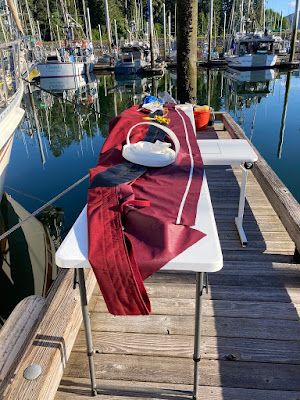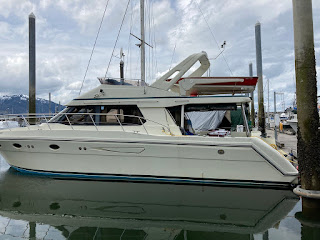Supplies used:
PTFE thread. PTFE thread is dirt/water repellant, fade proof, mildew/rot proof, highly resistant to abrasion, nonflammable, chemical resistant, permanent 100% UV resistant, and lifetime manufacturer warrantied. What's not to like? Well, it's $130.95 per 8oz cone, which is 1650 yds of thread. I know it's expensive, but how many times do you want to redo your stitching on your time-intensive project. Me- I never want to take it down, and restitch it. This thread fits the bill. The old canvas was obviously stitched with a Lifetime thread, it held as good as new.
Marine Grade Canvas, I used Sunbrella for the side curtains on the bimini, the weather cloths, and the sail covers. It's a solution dyed acrylic material that is UV, water, and mildew resistant. Sunbrella doesn't like abrasion though, so I put chafe guard where needed, it will also fray at cut ends, so it must be cut with a hot knife, or run a lighter along the edges. None of my Sunbrella edges are left bare, they are either tucked under, or are covered with seam binding, all safe from unraveling. Marine canvas has seen many new brands come onto the market, but I decided to stay with the recognized leader in durability.
Seamark material is Sunbrella acrylic on one side, and color-matched PVC on the other side, this creates a waterproof laminate. Our old dodger/bimini had this on the tops, and even though the zippers were failing, and the Sunbrella side didn't look very fresh, the underside looked brand new, totally sold me on the longevity, waterproof, and ease of cleaning. If we got any mildew on the underside, I would just wipe it clean with a Clorox wipe, and done. Another great feature, is that you can cut this with regular scissors, and it doesn't fray, no hot knife, or burning edges needed.
Seam binding I like to use Stamoid binding, it's a biased cut, double folded, binding made from a vinyl coated polyester fabric. This is also dirt, UV, mildew resistant, and since its vinyl, it can be cut without having frayed ends, another plus for not having to deal with the extra bulk, and hassle of turning under raw edges.
We used Zippers that can withstand the outside application the same way that the materials can. With over 40 zippers in the dodger/bimini, I don't want to take down the enclosure to replace zippers. I used #10, Vislon, which has teeth made from plastic that are molded into the zipper tape. Since zippers aren't made in all of the odd lengths I needed, I had to buy approximate sizes, and cut them to fit. I used stainless steel zipper stops after I cut to length, and they were very easy to install.
Webbing, Sunbrella makes a polyester acrylic webbing that is resistant to fading and matches their fabrics.
Seamstick is a double sided sticky basting tape, you use it before stitching, and it holds your intended seams together. It works great to hold your fabric so you can do straight seams, it also gums up your needle, bobbin, and mechanisms. They recommend that you use an alcohol swab occasionally to help remove any residue. I kept one in a baggie next to the machine, and used it constantly, if you don't, the thread will catch and break. Mostly I used 3/8" seamstick for the Seamark, and Sunbrella, but for the Makrolon windshield [more below], I used the recommended 1/2" Mylar/Kevlar basting tape.
Shelter-rite is a material I've never used before, but the folks at Sailrite recommend it for chafe protection. It's another vinyl coated polyester fabric material, but is formulated to be flexible in high abrasion areas, with high tear strength, and water resistance. I used it on all areas that needed a chafe guard, the dinghy cover, the leading edges of the dodger/bimini, and high wear areas inside the dodger/bimini, and curtains. Bill even used it to patch a couple of wear areas on the hypalon on the dinghy.
HH-66 is the vinyl cement used to glue Shelter-Rite to other surfaces. I sewed it where I needed chafe protection, but this is the glue Bill used to patch the dinghy. One of the advantages of using Shelter-Rite, is if in the future we see a need, we can glue more to it, Ex: I cut round holes for the inflation points on the dinghy, but if we decide we need a protective UV flap, we'll just glue one on.
Window Vinyl. Strataglass is a press, polished, and coated clear window vinyl. I used 30 gauge, for the side, and aft curtains on the bimini, and I choose this weight, instead of a heavier one, because we occasional roll up the curtains, and we needed a more flexible vinyl. Strataglass has a very detailed care sheet, and if followed, the longevity and clarity are increased. This vinyl is not an inexpensive solution, I've used cheaper vinyls before, and I expect this brand to outperform less expensive brands. It comes in 54"x110" sheets and is $204.95 a sheet, I bought three, and I will be using up all of two, and have the third for a spare.
Makrolon is a clear, optical grade hard polycarbonate window material. It's less flexible than window vinyl, but definitely has more clarity. We bought the VR Flexible Marine in 40 gauge from Interstate Plastics for the windshield. We would have liked the 60 gauge, but the 40 can be rolled up for shipping, and the 60 can't. These come in 52"x110" sheets, and it would have been cost prohibitive to try and ship a flat sheet that size. We ordered 2 sheets of the 40 gauge, and they came rolled for $60.00 in UPS shipping.
Pipe Flashing is manufactured to wrap around pipes that come through a roof on a house. Bill thought this might be a good solution to help waterproof the bimini, since we have four areas where standing rigging runs through it. He sealed it with Duralink 50, Super Adhesion Sealant. More details about this in the "what we did" section later.
 |
| 4.5 x 4.5 inch base; 4 inches tall... |
Snads, Snaps, Snap hooks, D rings, oh my. Snads are adhesive backed studs for snaps, no need to drill holes in your boat in order to install snaps. Snaps come in many flavors, pick which one suits the application, just make sure they're stainless steel, nickle won't hold up in the marine environment. Snap hooks, and D rings are part of the webbing assembly that provides support and tension to the dodger/bimini support structure.
Bolt Rope tape was used to secure the bottom edge of the dodger window to the cockpit coaming, and to secure the top edge of the weather cloths to to the hand rail.
EZ Lace is a fabric strip with lacing holes, it eliminates the need for grommets, I used it at the bottom of the weather cloths to secure them to the toe rail.
Foam pipe insulation: Hint: Make the dodger fit tight on the frame. Before final install, put foam pipe insulation over the top tubing frame members and then install your canvas for the final time. It will be that much tighter, reduce chafe, and have fewer hard surfaces for crew to bruise themselves on...
Tools:
Sailrite LSZ-1, this is a heavy duty sewing machine, that is somewhat portable. It's heavy, and you don't want to be moving it around a bunch. The LSZ-1 can sew through multiple layers of canvas, leather, and sailcloth. It has what is called a "walking foot", which means the presser foot works with the feed dogs, to advance the material through as you sew. The customer service for the company is terrific, and the maintenance videos are fantastic.
One of the most useful tools is the seam ripper. This handy tool helped me to pull apart the old canvas to make patterns, and to pull out mistakes on the new canvas. I'd like to say I didn't use it much, but I can't. I have about 5 of these blue ones, and then several others in different sizes, and styles. Purchase many, they break.
Water soluble marking pencils, grease pencils, and chalk pencils, all have their place, each is different in their ability to mark up patterning, canvas, vinyl, and window material.
Snap positioning kit. We used the already installed on Denali Rose, male part of the snap, and put new buttons on the canvas. This kit comes with a pin socket that you snap into the male part, and then you stick it through the canvas, and it marks where you need to install the button part of the snap. Easy, and accurate.
The Press n Snap Installation tool from Sailrite makes installing snaps easy, and quick.
I have my regular sewing scissors from Wiss, but to cut the Makrolon, I purchased Fiskars Titanium Nitride #8 shop snip from Amazon. They were difficult to hold, and they did okay, but Bill liked his heavier tin snips.
LSZ-1 sewing machine parts: Needles, Retaining Ring Cap Springs, Scarfed Shuttle Hook, and sewing machine oil.
We oiled, and changed the needle every new day I re-started to sew the Makrolon. I went through five #21 diamond point needles to sew it. For the rest of the canvas I use a regular #20, which is recommended for the PTFE thread, and Sunbrella. I don't normally change the needle so often, with Sunbrella, or other fabrics, I was just being extra cautious with the polycarbonate, to keep the sewing holes down to the minimum.
The retaining ring cap spring, (without going into too much detail), is a piece that sits underneath the faceplate, and is part of the assembly around the bobbin, if the needle strikes it, it creates a burr on the metal, and this caused thread breakage. I've gone through five of these, mostly while sewing the Makrolon.
Also from a needle strike, I had to replace the scarfed shuttle hook, which is another a piece of the bobbin assembly. I can use a jewelers file to fix the burr on the striked one, and still have a spare.
Hot Knife Think of this tool like a hot pair of scissors that seals the edges of your polyester material so that it won't ravel. It works great on Sunbrella, but because of the vinyl backing on Seamark, I didn't need it on that material.
Every time I order supplies from Sailrite, I include at least one other spare piece to the LSZ-1 machine. It's not that the machine breaks down, but IF it did, I want to be able to replace, or repair, and get back to sewing. If you live in Alaska, you know that shipping can be expensive, and time consuming, and having spares on hand can keep down-time to a minimum. I've also downloaded all of the maintenance videos, so if we have a need, we have the parts, and the instructions.
Sailrite has great customer service, and hundreds of instructional videos. They offer the videos for free, and I appreciate their knowledge, and the time commitment it takes to put them together. We've downloaded a majority of them, and store them on a hard drive. I like having them on hand, and using our data plan just once to download.
I bought the Seamark from Rochford Supply, Sailrite didn't have the amount I needed, and Rochford Supply had it in stock, with reasonable shipping.
I didn't choose the least expensive, I didn't choose the most expensive either, I researched and choose the longest lasting, and the best product for our application. Your results may vary.
Online Merchants:

















